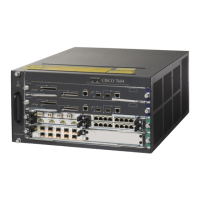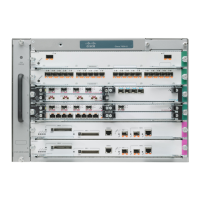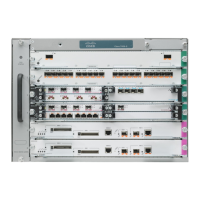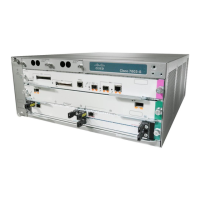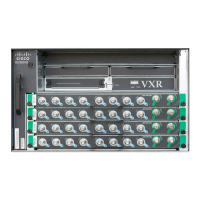32-45
Cisco 7600 Series Router Cisco IOS Software Configuration Guide—12.1E
78-14064-04
Chapter 32 Configuring PFC QoS
Configuring PFC QoS
Configuring the Policy Map Class Trust State
To configure the policy map class trust state, perform this task:
When configuring the policy map class trust state, note the following:
• Enter the no trust command to use the trust state configured on the ingress port (this is the default).
• With the cos keyword, PFC QoS sets the internal DSCP value from received or ingress port CoS (see
the “Mapping Received CoS Values to Internal DSCP Values” section on page 32-66).
• With the dscp keyword, PFC QoS uses received DSCP.
• With the ip-precedence keyword, PFC QoS sets DSCP from received IP precedence (see the
“Mapping Received IP Precedence Values to Internal DSCP Values” section on page 32-67).
Configuring Policy Map Class Policing
When you configure policy map class policing, note the following:
• PFC QoS does not support the set-qos-transmit policer keyword.
• PFC QoS does not support the set-dscp-transmit or set-prec-transmit keywords as arguments to
the exceed-action keyword.
• PFC QoS does not detect the use of unsupported keywords until you attach a policy map to an
interface (see the “Attaching a Policy Map to an Interface” section on page 32-49).
These sections describe configuration of policy map class policing:
• Using a Named Aggregate Policer, page 32-45
• Configuring a Per-Interface Policer, page 32-46
Note Policing with the conform-action transmit keywords sets the port trust state of matched traffic to trust
DSCP or to the trust state configured by a trust command in the policy map class.
Using a Named Aggregate Policer
To use a named aggregate policer (see the “Creating Named Aggregate Policers” section on page 32-35),
perform this task:
Command Purpose
Router(config-pmap-c)# trust {cos | dscp |
ip-precedence}
Configures the policy map class trust state, which selects the
value that PFC QoS uses as the source of the internal DSCP
value (see the “Internal DSCP Values” section on
page 32-17).
Router(config-pmap-c)# no trust
Reverts to the default policy-map class trust state (untrusted).
Command Purpose
Router(config-pmap-c)# police aggregate
aggregate_name
Configures the policy map class to use a previously defined
named aggregate policer.
Router(config-pmap-c)# no police aggregate
aggregate_name
Clears use of the named aggregate policer.

